Editor's Note: A shortened version of this article was published in Pharmaceutical Technology Europe's November 2021 issue.
GMP/GDP Inspections: Challenges and Opportunities Revealed by the COVID-19 Pandemic
An annual survey on inspections and audits has revealed opportunities to use more flexible approaches to optimize processes.
Superzoom - Stock.adobe.com
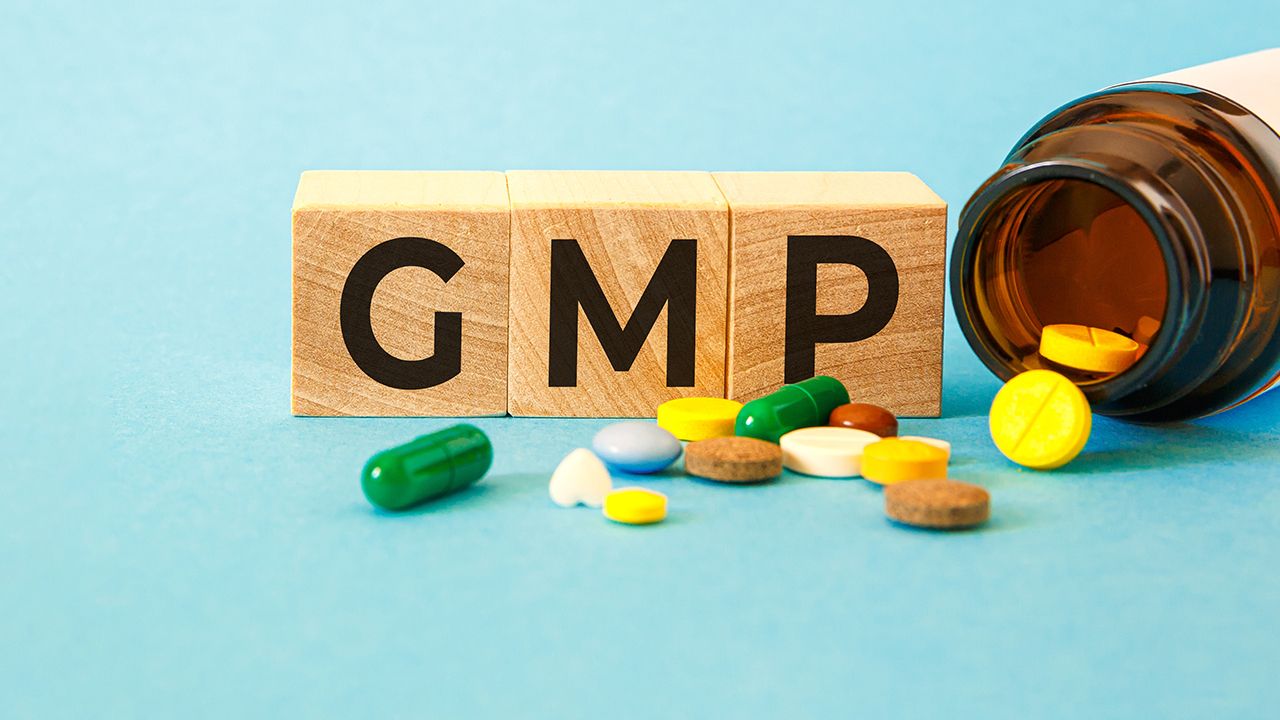
This paper presents the most recent results from the European Federation of Pharmaceutical Industries and Association’s (EFPIA’s) annual survey and their conclusions. The year 2020 demonstrated the ability of the pharmaceutical industry and regulators to be agile whilst maintaining the same high standards as previous years because of the COVID-19 pandemic.
Inspections of a firm’s manufacturing operation are essential to evaluate commercial manufacturing capability, adequacy of production and control procedures, suitability of equipment and facilities, and effectiveness of the quality management system in assuring the overall state of control (1). Notably, pre-approval inspection (PAI) includes the added evaluation of authenticity of submitted data and link to dossier (1).
Since 2003, EFPIA has conducted and reported an annual survey of good manufacturing practice (GMP) and good distribution practice (GDP) inspections and related International Organization for Standardization (ISO) audits to monitor inspection activity and trends in research-based industry (2–4). The annual survey is performed to shape the future based on data. Companies can compare the results with their own situation.
Based on the outcome of the survey results, the efficiency and reliance approaches can be demonstrated. The conclusion of the data assessment supports promoting alternative approaches to inspection with physical (on-site) presence.Harmonizing requirements and expectations will maximize effectiveness and reduce uncertainties for companies and inspectorates. Furthermore, the annual survey intends to demonstrate the benefits of Mutual Recognition Agreements (MRAs) and Pharmaceutical Inspection Co-operation Scheme (PIC/S) membership in optimizing use of inspection resources while maintaining patient safety (5).
Scope of the survey
As in previous years, the scope of the EFPIA regarding the 2020 regulatory GMP/GDP inspections and related ISO-certification audits included inspections by regulatory authorities and Notified Bodies at manufacturing sites and commercial affiliates for both manufacturing of investigational medicinal products (IMPs) and commercial products. The scope included inspections inside (i.e., domestic) and outside (i.e., foreign) the regulatory authority’s country or region.
EFPIA asked companies in the survey to specify all inspection tools (or a combination of them), including on-site, virtual (‘remote’), or paper-based, as well as reliance and recognition approaches used. The product type manufactured at the site and the duration and outcome of each inspection were reported. Companies also reported the type of inspection and whether inspections were scheduled or unannounced. EFPIA also asked a set of questions related to how inspections had been performed and about the impact of the restrictions during the pandemic.
Results and trends
The 2020 survey received responses from 25 global research-based pharmaceutical companies (EFPIA members) and eight local companies reported by National Trade Associations. Full results are available on the EFPIA website (4). As expected, there were significantly fewer inspections overall in 2020 (approximately –40%, 1106 inspections, compared with 1733 inspections in 2019 and 1748 inspections in 2018 [4]) while the number of manufacturing sites included in the survey was comparable with previous years (Table I).
Table I. Data from the 2020 survey compared with 2019 and 2018.
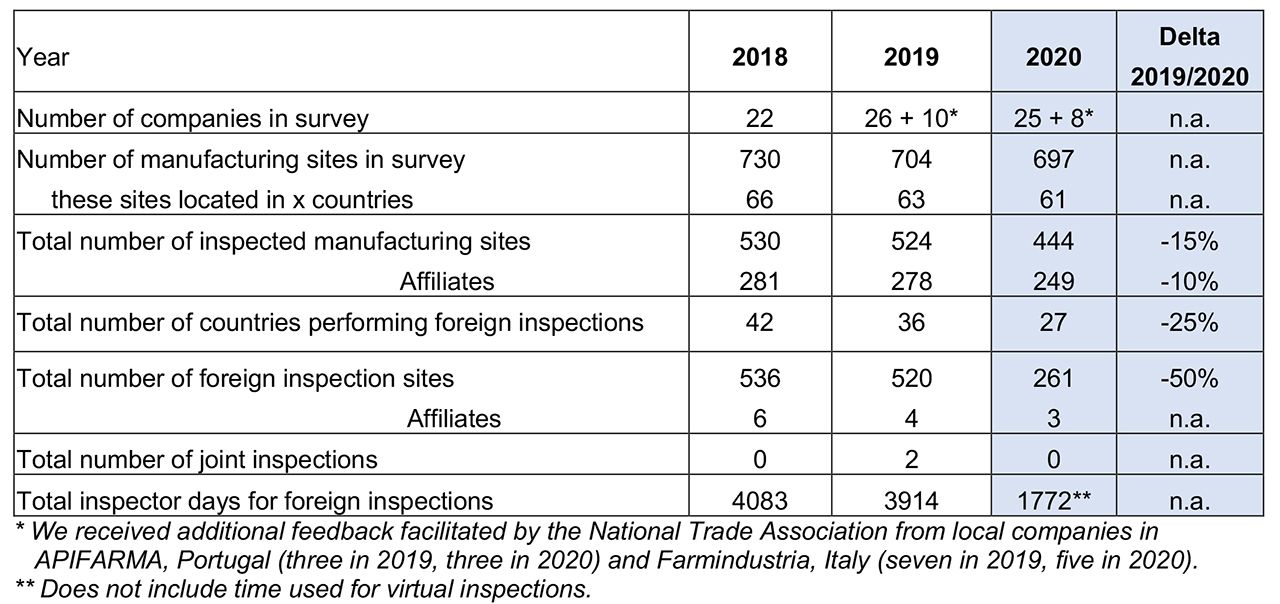
The total number of foreign inspections in 2020 was reduced by approximately 50%. However, the number of manufacturing sites without an inspection (domestic or foreign) was in the same range as in previous years (36% in 2020; 26% in 2019; 31% in 2018 [4]). Therefore, the regulatory oversight of manufacturing sites is consistent.
Domestic inspections. Domestic inspections are defined as inspections performed in the country/region of the inspectorate. In 2020:
- There were 453 domestic inspections (including ISO-certification audits) at manufacturing sites, compared to 709 domestic inspections in 2019.
- Inspectors spent 2321 days on-site in 2020 for domestic inspections, compared to 4316 days in 2019.
- Domestic inspection with physical presence took an average of 3.1 days in 2020 (2.7 days in 2019) at the site, with an average of 6.7 inspector days in 2020 (6.3 in 2019)
- The ratio of the inspection type performed was almost unchanged in 2020 compared to 2019; there was no increase in domestic for-cause inspections.
- Few domestic inspections (0.3%) resulted in follow-up regulatory action leading to interruption of supply (versus 0% of foreign inspections) and 11% of domestic inspections resulted in follow-up regulatory action, which was not leading to an interruption of supply (versus 7% of foreign inspections).
Foreign inspections. Foreign inspections are defined as inspections performed in a third country/region to the inspectorate. In 2020:
- Twenty-seven different inspectorates (where the European Union [EU] counts as one inspectorate) performed 264 foreign inspections, compared to 36 inspectorates performing 526 foreign inspections in 2019.
- The maximum number of foreign inspections of one site was nine.
- Foreign inspections with physical presence took an average of 4.3 days (3.6 in 2019), with an average of 9.5 inspector days (7.4 in 2019).
- Foreign pre-approval inspections (PAIs) increased from 19% in 2019 to 32% in 2020; foreign surveillance inspections were reduced from 81% in 2019 to 68% in 2020.
- All (100%) foreign inspections had a positive outcome (defined as no disruption to product supply or to approval of new product applications).
- More than half (51%) of foreign inspections were reported to be conducted by a PIC/S participating authority in a country where the inspectorate is also a PIC/S participating authority).
Locations of inspected manufacturing sites. Over 50% of all inspections reported were at sites in Europe, indicating that research-based manufacturers have a strong presence in this region. The locations of manufacturing sites for foreign inspections are shown in Figure 1, along with a breakdown of EU member states (including the United Kingdom, for 2020).

Figure 1: Locations of manufacturing facilities hosting foreign inspections. [ALL FIGURES ARE COURTESY OF THE AUTHORS]

Trends in the data. The pandemic restrictions drove the need for inspectorates to use alternative approaches to on-site inspections at manufacturing sites and affiliates after 1 March 2020.
- Use of the virtual (‘remote’) tool, document reviews (paper-based inspections), and the hybrid approach (virtual and on-site) increased in domestic inspections; nevertheless, a large percentage of domestic inspections were still conducted on site after the outbreak.
- Use of virtual (‘remote’) tools and document reviews (paper-based inspections) increased in foreign inspections and the proportion of inspection with physical presences was reduced.
- The number of inspections decreased from >200/month before the outbreak to around 125/month after 1 March 2020.
Some data remained unchanged, for example:
- The proportion of unannounced versus scheduled inspections has remained consistent since EFPIA started collecting these data in 2015, with scheduled domestic inspections around 60%, scheduled foreign inspections around 32%, unannounced domestic inspections around 7%, and unannounced foreign inspections around 1% of the total.
- The outcome of unannounced inspections at manufacturing sites is comparable to those that are announced: there are around 87% of scheduled inspections and 95% of unannounced inspections having no follow-up actions to be provided by the company. These proportions are consistent since EFPIA started collecting this specific data in 2015.
Companies’ answers to survey questions revealed the following:
- No change in the number and severity of observations was reported.
- No significant differences in the outcome of GMP-, GDP-inspections, or ISO certification audits were reported.
- Companies (>90%) reported no change was observed in the number or type of observations.
- Individual companies reported shifts in observations towards quality system areas, risk-assessment thoroughness, documentation accuracy, documentation practices.
- Companies reported no challenges regarding drug shortage prevention measures.
Trends in the number of reported foreign inspections are summarized in Figure 2. While the member of foreign inspections performed by Russia and Japan are constant all other inspectorates reduce the number of foreign inspections in 2020.
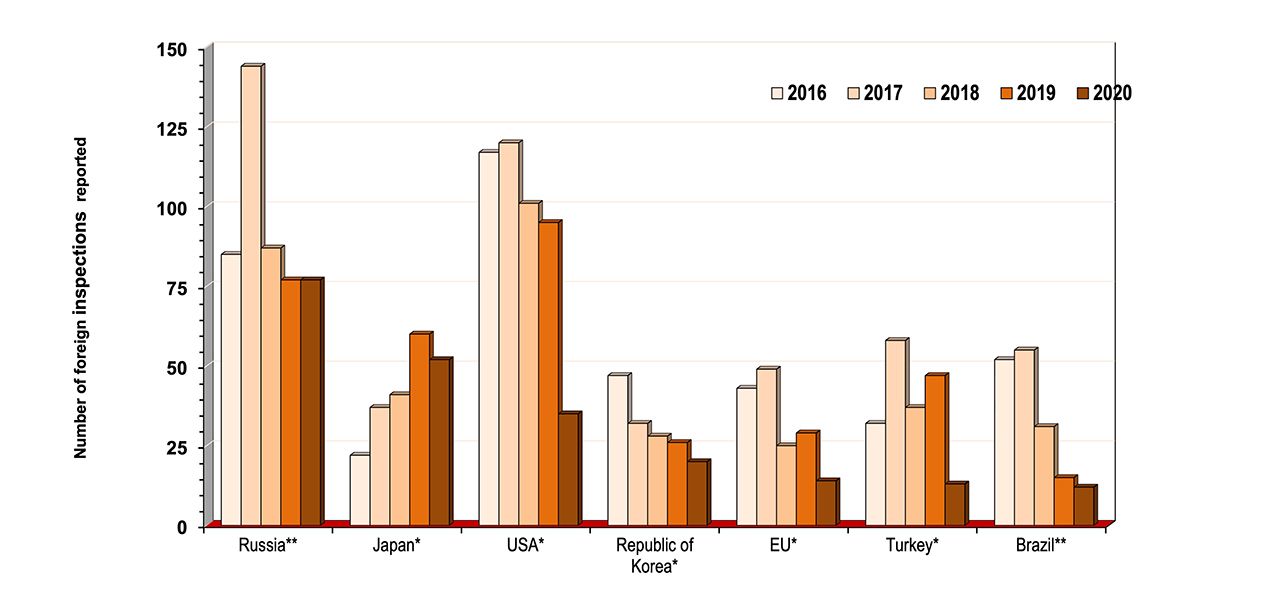
Figure 2: Trends in the number of foreign inspections. PIC/S is Pharmaceutical Inspection Co-operation Scheme, EU is European Union. USA is United States of America, EAEU is Eurasian Economic Union.
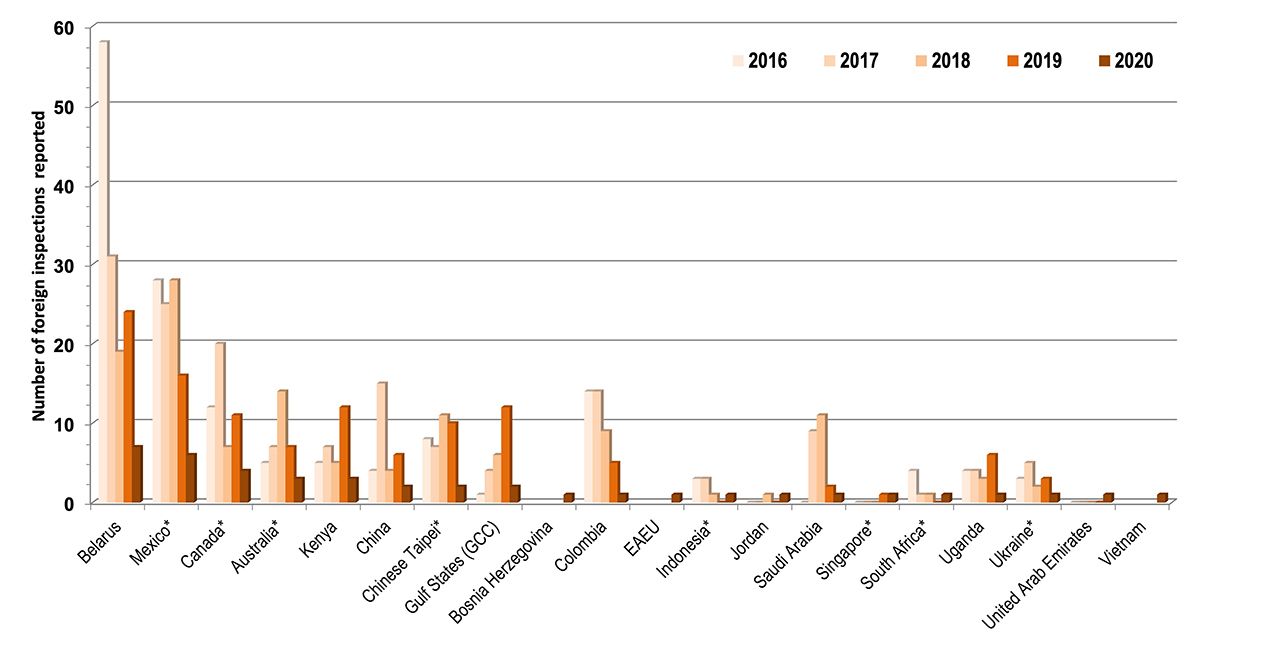
Efficient application of inspection process and tools
In 2020, the pandemic revealed the range of tools available to inspectorates and the flexibility offered by the toolbox for conducting inspections using physical presence, document review, virtual presence, and experience, recognition, and trust. Implementation of these tools confirm compliance and capability implementing efficient risk-based approaches (Figure 3). Inspectorates used a variety of tools stand-alone and in combination (4). The tools are not equivalent for the knowledge gained and trust applied. Each approach has challenges and opportunities.
Figure 3: Inspectorates used a variety of tools in 2020. GMP is good manufacturing practice, GDP is good distribution practice, PAI is pre-approval inspection.
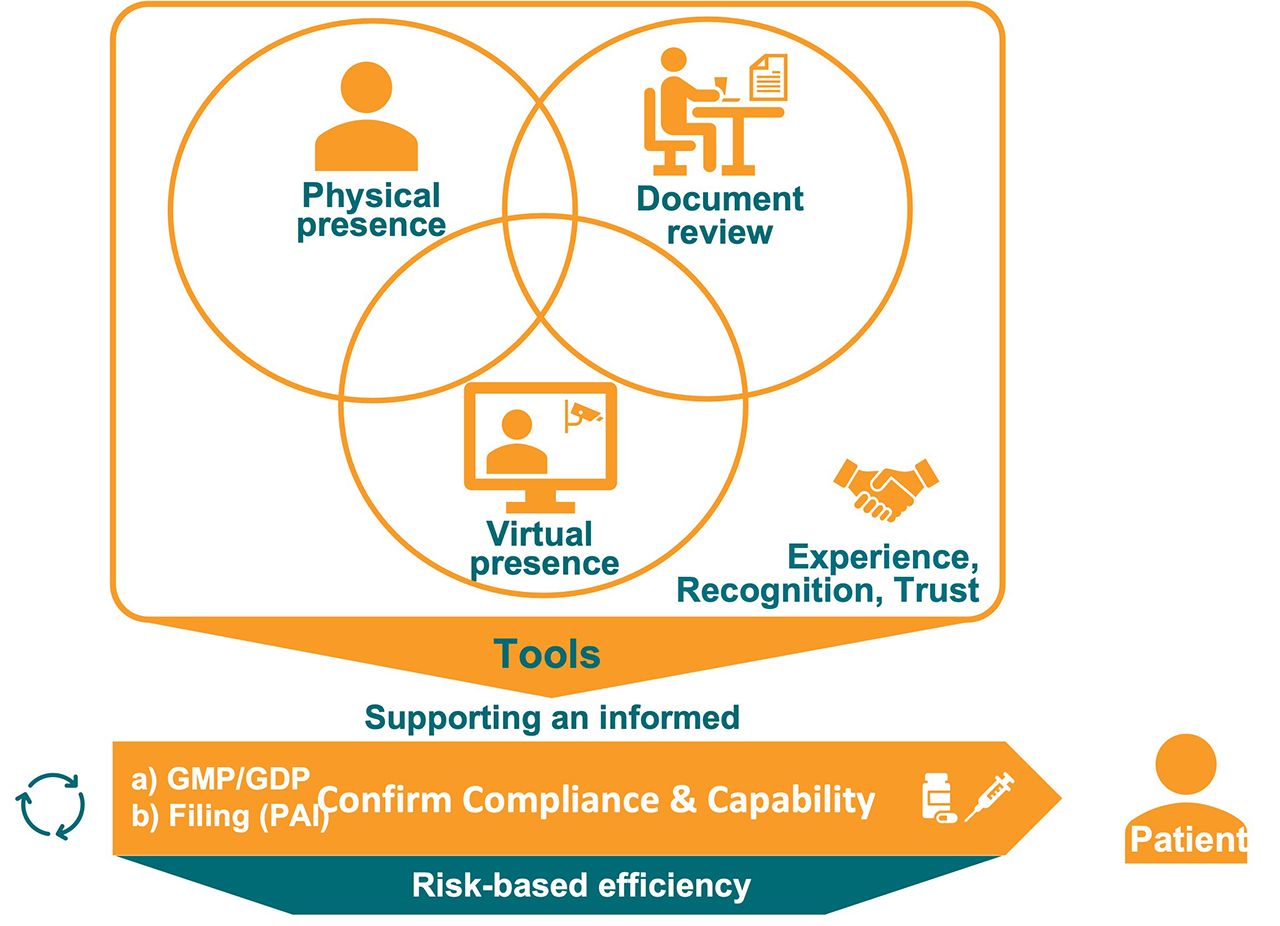
Physical presence. The COVID-19 pandemic impacted the ability of inspectorates to be present on site to perform inspections.
- More than 80% of domestic inspections had at least a partial on-site presence. In conclusion, most domestic inspections still occurred with an on-site facility review after the outbreak of COVID-19, which we dated to 1 March 2020 when restrictions started.
- Less than 25% of foreign inspections were conducted with on-site presence (compared to >80% in previous years); inspectorates that did use on-site presence for foreign inspections included Belarus, EU, and United States.
Virtual presence. The virtual (‘remote’) tool offered a logical alternative for inspectorates mostly adopted for performing foreign inspections in 2020 (6,7). Implementing this tool varied: it was used, for example, mainly by EU inspectorates (which employed virtual and on-site tools in 50:50 ratio), Republic of Korea, and Russia (Figure 4).
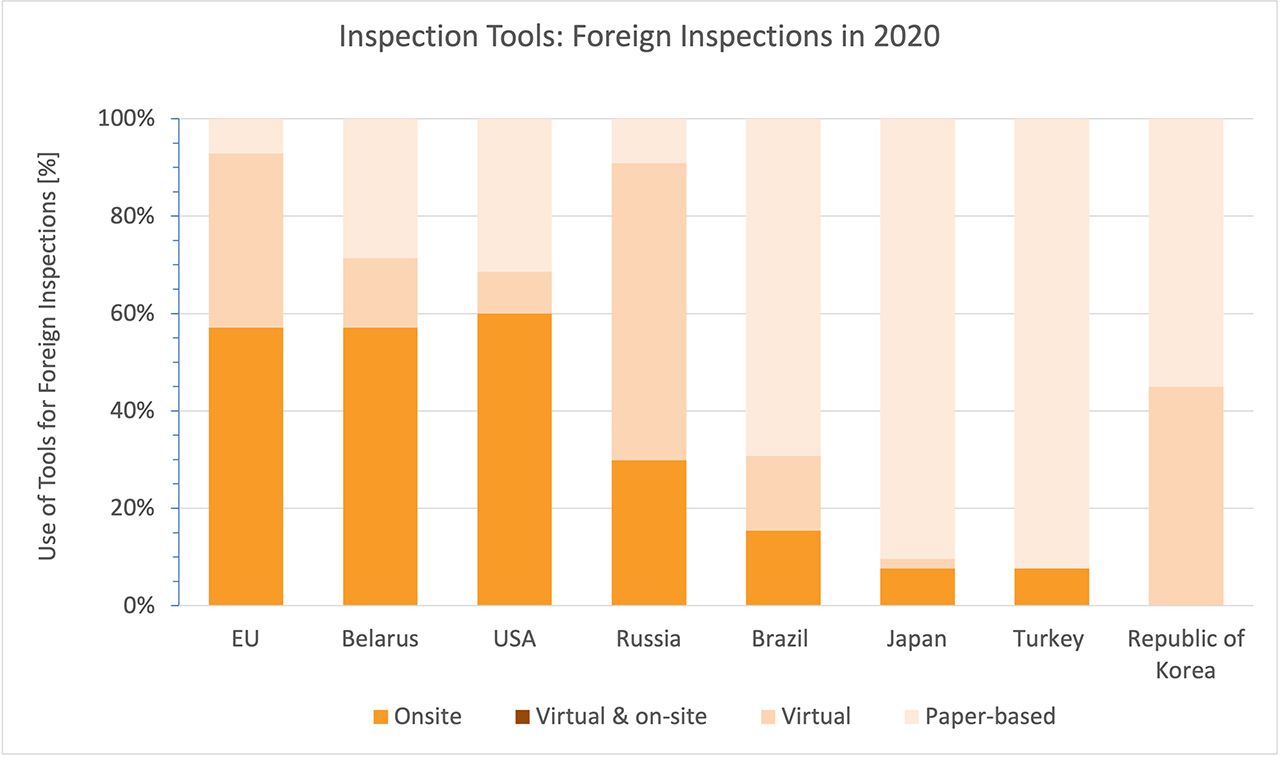
Figure 4: Examples of inspectorates varying in their use of inspection tools. No agency was reported to use a hybrid approach (e.g., on-site and virtual) in foreign inspections. This hybrid approach was used mostly for domestic inspections, for example by European Union (EU) member states and Switzerland.

Some inspectorates used a hybrid approach, with a combination of on-site presence and the virtual tool. This combination was used mostly for domestic inspections (Figure 2). Use of the virtual tool alone was reported for domestic inspections by EU inspectorates (including Belgium, France, Germany, Ireland, Poland, and UK), the US, and Brazil.
Feedback provided by companies on the use of the virtual tool varied. Some companies reported technological and privacy issues, and difficulties with time zone management. The point was made that certain inspectorates (e.g., Russia) did not make it clear that the inspection had finished (i.e., no additional discussions are needed to formulate the regulatory decision). Companies reported that a defined agenda would be useful. Other companies reported that a longer time was needed when preparing for a virtual inspection, with many more documents being requested in advance than with other tools. It seemed that both industry and regulators were on a learning curve with the application of the virtual tool. Nevertheless, inspections proceeded at a time when travel was severely restricted.
Note that there was uncertainty in the 2020 data evaluation about the number of inspector days used for virtual inspections. If a company named more than 10 days for a virtual inspection, we set the value to 10 days. Our reason for this value was because we assumed that not all days specified by the company were full days when the inspection was performed. Similarly, with paper-based inspections, some companies reported the start and end date of a paper-based inspection, even if the days in between were not used. Thus, the duration of paper-based inspections was not accounted for.
Document review. Documents to be submitted prior to an inspection continued to be used as a tool in 2020, when there were 139 paper-based inspections (compared to 62 paper-based inspections in 2019) reported, primarily involving inspectorates from Japan (40%), US (10%), Republic of Korea (7%), and Turkey (7%).
Although document reviews without virtual interaction or physical presence of the inspector can be less time-consuming for a company and inspectors, provision of documentation still uses resources, and the document request process is not currently harmonized. Companies can be asked to provide documentation in advance not just for paper-based or virtual inspections, but also for all inspections with physical presence. In addition, translations may be required with the risk of misinterpretation, even with the best translation service. This process can be time consuming. Data from a separate survey in 2020 revealed that up to 700 documents, of a broad variety, have been requested before an inspection with a physical presence (4).
Experience, recognition, and trust. In 2020, there were seven inspections (five foreign; four of them as of an MRA or Memorandum of Understanding [MoU], and two domestic) reported where it was indicated that licences had been renewed without performing an inspection (’waived’ inspections). EFPIA advocates the use of waivers and leveraging the benefits of fully implemented MRAs. An effective risk management process adopted by the inspectorate (8) allows for waivers. Waivers are increasingly granted for sites located in a country where a formal MoU is established or in a country where the inspectorate is a member of PIC/S, provided that all tools required (e.g., on-site, virtual, paper-based, reliance on prior knowledge) are available.
Inspections by the EU in the US have dropped by 80% since 2017 (Figure 5). The study revealed that there were 50% fewer foreign inspections by the US in the EU compared with 2019 (when the MRA between the two territories was fully implemented). It is expected that this trend will continue going forward, and the observed reduction of inspections is not just a reflection of pandemic restrictions or government shutdowns due to the budget situation in the US.
Figure 5: Number of foreign inspections by United States in European Union and vice versa.

Recommendations for the future
The COVID-19 pandemic caused a significant reduction in the number of inspections in 2020, but there was no discernible drop in oversight of manufacturing facilities ensuring that industry maintained high standards of quality, safety, and efficacy of medicines. The authors feel that lessons learned from this year’s survey could be permanently implemented, in compliance with existing legislation (9).
Risk-based approach for inspection planning. A risk-based approach to planning and conducting inspections was used more effectively in 2020, and the authors advocate that it will continue in future years, using the PIC/S guidance on risk-based inspection planning (8). This approach facilitates planning of inspections by regulators by providing risk ranking of sites, along with a suggestion for the number of inspectors and scope (including focus and depth) of the next surveillance inspection.
Best use of the different inspection tools. The pandemic drove companies and inspectorates to seek new, innovative tools to provide alternatives to inspection with physical presence. The virtual tool was used extensively; although companies reported certain difficulties. It was an enabler for an informed compliance decision by the inspector. Some companies found it difficult to interact virtually, especially if they experienced technological problems or if an interpreter needed to be used. In this case, the involvement of local affiliates in foreign virtual inspections may allow better communication. Hybrid approaches (i.e., a combination of virtual and physical presence) could be valuable in future years. Application of virtual tools can confirm compliance while replacing a physical presence or a document assessment by issuing a GMP-certificate to guarantee continuous patient access, for example. The authors acknowledge the variety of opinions on the interpretation of the legislation, if virtual assessments can be used as the basis for a legal decision to confirm GMP compliance and capability of a site to manufacture a product but understand that gaining knowledge using virtual tools is better that only do a document review. It is most important that in the end, patients continuously receive good quality medicines (9).
Inspectorates also made more use of existing tools, particularly paper-based inspections. Supporting document reviews as part of inspections, EFPIA recommends that a standard set of documents could be agreed upon the various harmonization initiatives to be available for each site to the inspector (5). The use of such a globally aligned and consistent list of required documents in English, as acceptable would enable advanced preparation and ensure consistent documentation reviews. This would simplify the process by eliminating variability in the requested documents. Such variability results in a time-consuming nonvalue added exercise for the collection of a very large number of documents (Figure 6).
Figure 6: Proposed standard document package for consideration by Pharmaceutical Inspection Co-operation Scheme based on a separate survey of 270 data points (1 January 2019–31 June 2020) supported by 11 companies.
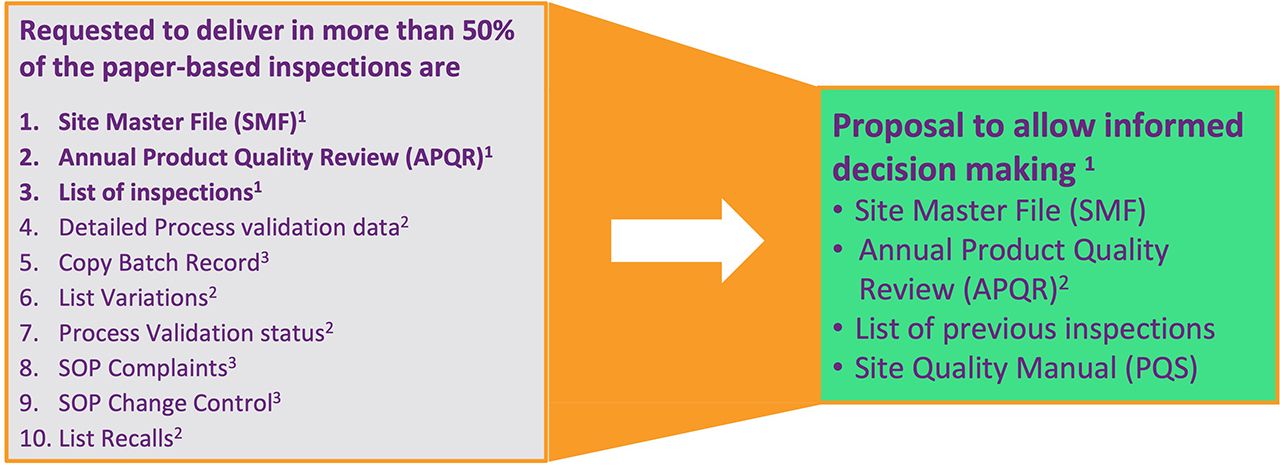
Potential differences in terminology could be harmonized, for example by PIC/S, that local regulators could use to develop a specific glossary linking local terminology with these harmonized terms. This standardized package would allow streamlining of efforts so that companies and inspectors could be more focussed and effective.
Reliance for reducing redundancies. Although the number of inspections overall was reduced significantly, the proportion of sites undergoing an inspection remained comparable with previous years. This suggests that there has been duplication of inspections in previous years, a situation that we are seeking to improve.
Despite the reduced number of inspections, industry continued to deliver safe and effective medicines of an appropriate quality, although companies noted delayed approvals because of postponing scheduled pre-approval inspections. Whether there will now be a surge in PAIs remains to be seen. The authors suggest that the duration of a PAI could be reduced at least, for example, to one day focussing on the clarification of the content of the dossier by referencing the results from surveillance GMP inspections (e.g., by a PIC/S member inspectorate or under existing MRAs, such as the EU-US MRA, which is an agreement for recognition of inspections, including PAIs). We encourage continuing the discussions of the scope of that and other MRAs to improve efficiency in planning and performing of all types of inspections.
The robust domestic inspection system that was evident in 2020 (10) can be leveraged going forward to allow reduction in redundant on-site foreign inspections. EFPIA supports the global implementation of the harmonized PIC/S (11) and WHO reliance guideline (12) to perform remote assessment of GMP facilities based on reliance. The guideline describes how “informed decisions on the GMP compliance of a manufacturing facility can be made, in certain circumstances, based on the outcome of work by another regulatory authority or authorities” (11). It allows for reliance outside of existing MRAs and recommends confirming GMP compliance based on available data, where appropriate, to reduce regulatory burden and allow a more efficient deployment of global resources to bring products to patients much faster.
Lessons learned from GMP/GDP inspections during the pandemic. The COVID-19 pandemic showcased opportunities for future adoption in the GMP/GDP inspection practices.
- Using remote (desktop) reviews
- Increased reliance on decisions by recognized inspectorates (e.g., PIC/S participating authorities)
- Further development and implementation of MRAs
- Inspection waivers granted automatically if an inspection report by a recognised inspectorate is available (‘unilateral waivers’).
We believe that the legal requirements for GMP/GDP inspections can be fulfilled with increasing application of reliance approaches based on the positive experience gained during the pandemic, because there was no negative impact observed on the oversight of compliance of manufacturing facilities (13).
Conclusion
The following opportunities to optimize the inspection process based on the EFPIA 2020 survey outcome could be considered:
- reliance on available information about inspections at a manufacturing site
- standardization of the package of documents to streamline efforts for all inspection types
- focus on domestic inspections and on sites never inspected before.
Agencies’ risk-based inspection planning approaches could recognize all available inspection tools (i.e., physical or virtual presence), review of and reliance on documents, or considering combinations of those tools. Furthermore, EFPIA suggests leveraging existing MRAs such as those between EU–Japan, EU–US and accepted comparable standards like inspections conducted by an inspector from a PIC/S participating authority as an opportunity to simplify the inspection process (4,11).The results from the survey on the 2020 data reveal that inspectors ask for many documents, especially since the pandemic, to be submitted prior to the inspection, which is very time- and resource-consuming for industry (4). Inspections with virtual presence increases knowledge. This can provide better bases for decision-making, rather than just requesting and reviewing paper documentation. Finally, a regulatory decision on GMP compliance and capability of the manufacturing site will support a smoother regulatory approval process leading to earlier and continuous access of medicines to patients (14).
Acknowledgement
The authors thank the other EFPIA inspection topic team members for the discussion: Janeen Skutnik Wilkinson, Biogen; Julien Parain, Sanofi; Sinéad Redmond, BMS; Ute Lichtenberg, Bayer; Véronique Davoust, Pfizer and Michele Hunter for support as well as Nidia Acevedo, Dinesh Khokal and Mark Schweitzer at Amgen.
References
1. ICH Quality Implementation Working Group, Implementation of ICH Q8, Q9, Q10: Inspection, Training Programme (November 2010).
2. S. Rönninger, et al., Pharm. Tech. Eur., 29 (1) 6–10 (2017).
3. S. Rönninger, et al., Pharm. Tech. Eur., 29 (2) 5–9 (2017).
4. EFPIA, Annual Regulatory GMP/GDP Inspection Survey 2020 Data, Summary Document, 17 May 2021. Further information is provided, taken from the raw data (summaries from previous year as also published).
5. EFPIA, Enhanced Good Manufacturing and Good Distribution Practices (GMP/GDP) Inspection Efficiency, Position Paper, Final v8a, 19 May 2014.
6. EMA, Guidance Related to GMP/GDP and PMF Distant Assessments, Guidance Document, 15 Oct. 2020.
7. FDA,Remote Interactive Evaluations of Drug Manufacturing and Bioresearch Monitoring Facilities During the COVID-19 Public Health Emergency, Guidance for Industry (April 2021).
8. PIC/S, A Recommended Model for Risk-Based Inspection Planning in the GMP Environment, Recommendation, 1 Jan. 2012.
9. EFPIA, Alternative GMP/GDP Inspection Practices in a Pandemic Situation (COVID-19) and Beyond, Reflection Paper, Final v3, 28 May 2020.
10. PIC/S, COVID-19 Risk Assessment for National Routine On-Site Inspections, Assessment Form, 15 July 2021.
11. PIC/S, GMP Inspection Reliance, Guidance Document, 1 June 2018.
12. WHO, Annex 10: Good Reliance Practices in the Regulation of Medical Products: High Level Principles and Considerations, Technical Report (2021).
13. EFPIA, Opportunities for Optimising the GMP Inspection Process Post Pandemic, Position Paper, July 2021.
14. IFPMA, IFPMA Position on Convergence of Good Manufacturing Practice (GMP) Standards and Related Inspections, Policy Position, Revised January 2020.
About the Authors
Dr.-Ing. Stephan Rönninger,* sroennin@amgen.com, director, Quality External Affairs, Amgen (Europe) GmbH (corresponding author); Andrea Kurz, vice director, External Collaboration Europe, F. Hoffmann-La Roche Ltd.; and Francisco Raya, quality assurance head, Almirall.
*To whom all correspondence should be sent.
Article Details
Pharmaceutical Technology Europe
Vol. 33, No. 11
November 2021
Pages: 36–39
Citation
When referring to this article, please cite it as S. Rönninger, A. Kurz, and F. Raya, “GMP/GDP Inspections: Challenges and Opportunities from COVID-19,” Pharmaceutical Technology 33 (11) 2021.
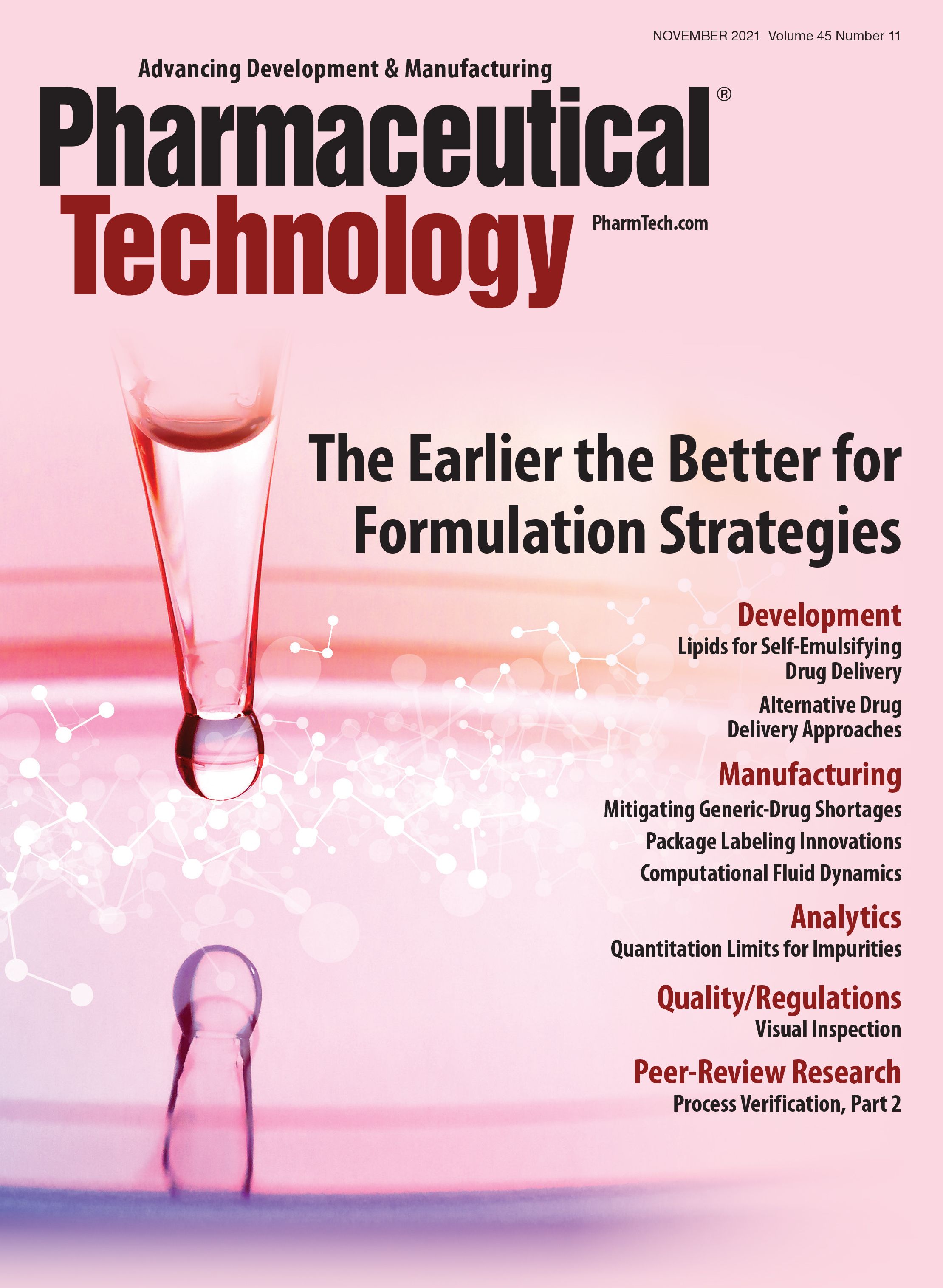
PacBio Chosen as Tech Partner for Global Alzheimer’s Disease Research Project
April 23rd 2025The project, the North African Dementia Registry, will unite multiple entities for the purpose of developing a comprehensive dataset to advance the research community’s understanding of Alzheimer’s disease and other dementias in diverse populations.